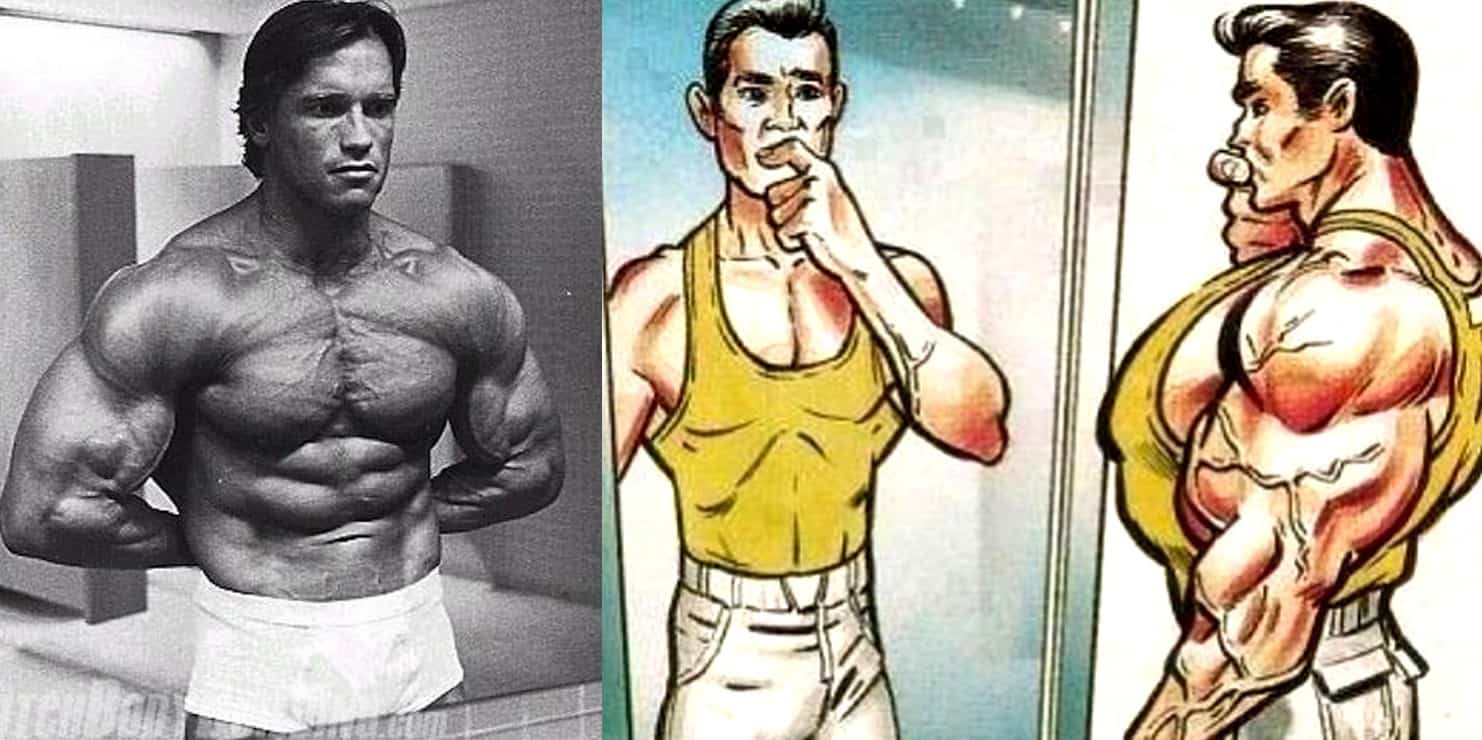A disruption in the body image similar to anorexia can include being concerned with muscle growth. Hundreds of thousands of men are now affected by bigorexia (muscular dysmorphia).
Muscle growth is such a total problem for some men that they will skip major events, continue exercising despite the pain or broken bones, and lose their job rather than disrupt their physical development schedule.
Bigorexia sometimes referred to as muscle dysmorphia, is a health disorder that can cause the body to continually think about building muscle.
Bigorexia is a type of body dysmorphic disorder that shares some of the same symptoms as other conditions, including anorexia nervosa.
Bigorexia, especially among young adults, appears to be on the increase. Let’s take a look at the muscle dysmorphia signs, risk factors, coping mechanisms, and treatments available.
What is bigorexia?
The Diagnostic and Statistical Manual (DSM-5) describes bigorexia as a body dysmorphic condition that causes concern about the fact that your body is too small or not muscular enough.
- You are fixated on the fact that something is wrong with how your body looks when you have bigorexia. That can affect your actions.
- There are many things that muscle dysmorphia can look like, including:
- Spending hours in the gym, pushing your body well beyond its limits and feeling obligated to come back and do it again the very next day.
- Following diets on a path to weight loss and muscle addition that never seems to stop
- hating the body, you exist in and feeling that these perceived flaws of your body are equally obvious to anyone who sees you
When left untreated, bigorexia can escalate and lead to:
- Steroid misuse
- Depression
- Thoughts of suicide
Other mental health problems can also play a role in this disease, such as disordered eating and obsessive-compulsive disorder.
In the medical community, there is still some controversy on whether bigorexia can be categorised simply as a dysmorphic condition of the body, or whether it has anything in common with eating disorders or addiction.
What are the symptoms of bigorexia?

The key trait of bigorexia is the belief that your body is never muscular enough no matter how hard you try. While some women bodybuilders have also been identified with similar symptoms, the disease is known as more common in males.
Most males with bigorexia are weightlifters, but this does not indicate that most weightlifters are bigorexia. Compared to average weightlifters who report spending up to 40 minutes a day thinking about body growth, men with bigorexia report worrying about their bodies being under-developed for five or six hours a day.
There is some speculation that this alone accounts for increased knowledge of physical imperfection in men and a quest to achieve the ideal body with the rise in gymnasium provision and attendance. Optimistic estimates placed bigorexia as affecting hundreds of thousands of men.
Mirror Checking
One research reported bigorexic males checking out up to 12 times a day. This contrasts with other weightlifters, about three times a day.
Diet
In this syndrome, very restrictive diets are frequently involved. Bigorexics are seldom eaten at the house of another person or at a restaurant because they can not monitor the dietary balance or know exactly what has gone into the preparation of food. Men have been known to develop eating disorders like bulimia.66.
Measuring Up
Bigorexic males are continually contrasting their physique to that of other males. Their expectations are invariably inaccurate. They will judge themselves as smaller even while watching men of the similar physique.
Drugs
Among bigorexic agents, the use of anabolic steroids is popular. Despite suffering side effects such as increased aggression, acne, breast enlargement, impotence, baldness, impotence, and testicular shrinkage, men continue to use steroids.
Body Fat
Typically men with bigorexia are worried about the percentage of body fat they bear instead of being overweight.
Psychological Factors
Unlike many bodybuilders who love the ability to publicly display their physique, bigorexics are not. Due to shame about their body shape, many would hide away for days at a time.
A man can avoid sex with his wife so as to conserve energy, for his bodybuilding was identified in one study.
Men with bigorexia usually have low self-esteem. Many say that their physique has been teased at school, leading to a fixation on “looking good.”
However, the effort to catch up is never fulfilled and results in a weak sense of self and emptiness feelings. Studies also found that there was a history of anxiety disorder in 29 per cent of men with bigorexia, and 58 per cent had some other type of mood disorder.
Are there risk factors for developing bigorexia?
It is not always clear who is going to suffer from bigorexia.
Some life experiences and underlying psychological factors can make you more likely to have body dysmorphia.
There can be muscle dysmorphia in both women and men. In having this disorder, negative experiences during childhood, such as bullying or teasing about your size, can play a role.
A survey of more than 14,000 young people in 2019 showed that 22% of males and 5% of females reported disordered eating habits associated with working out and becoming more muscular.
The same research also showed that you could be at greater risk for bigorexia if you have other mental health problems. It is much more likely that people in bodybuilding, certain sports, or wrestling cultures may have this disorder.
Are there treatments for bigorexia?
You may be searching for ways to control your symptoms if you have bigorexia.
While there are some things you can do at home, you may need to seek treatment for your condition from a professional mental health provider.
Treatment Options
No systematic studies have been developed at the time of writing to compare the efficacy of one treatment with another, either individually or in combination.
A specific issue with the disorder is that men seldom see themselves as having a problem and are reluctant to come forward for treatment, rather than like anorexics.
The disorder itself arises partially as a reaction to feelings of depression and loss of self-esteem, so accepting defeat is coming forward for treatment.
A mixture of educational and psychotherapeutic approaches has started to show positive outcomes where men have come forward. Cognitive-behavioural approaches emphasise the detection and adjustment of thought habits towards more practical and achievable objectives.
Co-morbid mood therapy and anxiety disorders are significant. Potential treatment packages may well guide such interventions, but more comprehensive studies are now needed.
Self-care measures
Today, by making improvements, you can start treating muscle dysmorphia, including:
- Limit your weightlifting and fitness practices to 30 minutes per hour per day.
- Stopping the use of hormones, protein shakes and supplements for fitness.
- Deleting your smartphones with calorie trackers and fitness applications
Identify and fix other habits that can impair the condition, such as purging, binge eating, smoking, and heavy alcohol consumption.
You may also want to start your therapy with the National Eating Disorder Helpline by calling or beginning an online conversation.
Medical treatments
You may also want to talk about your symptoms with a mental health professional, especially if muscle dysmorphia affects your relationships and causes you to take self-harm into account.
Such therapies may include:
- In order to recognise thought patterns and change the way your brain responds, cognitive behavioural therapy (CBT)
- exposure therapy/ritual prevention (E/RT) to help you find alternative ways to deal with harmful preoccupations
- To adjust the way you perceive your body, perceptual retraining
Your physician can prescribe a drug such as a selective serotonin reuptake inhibitor (SSRI) if you have muscle dysmorphia along with other mental health conditions to help regulate your moods during care.
How do I cope with bigorexia?
Living with bigorexia implies having working methods for coping. These methods will help you with your symptoms and provide you with a sense of control:
- For people with body dysmorphia, engage in rehabilitation and support groups.
- Meditation and deep-breathing techniques for practice.
- Spend your active time outside rather than in the fitness centre.
- Keep a journal where the symptoms and the way you feel are written down.
Whenever you can, recognise stimuli and stop them. From a movie where people look the way you think you should to a person who criticises your body, a trigger may be anything.
If you or someone you know is having these symptoms, you are far from alone while dealing with bigorexia.
It is now estimated that there is some form of body dysmorphia in 1 in 50 individuals. A documentary called “Bigorexia” has shed light on the way the elite bodybuilding culture is influenced by muscle dysmorphia.
Sharing about your experiences with bigorexia with a therapist, family member, or someone else you trust can be a positive first step in gaining back control of your life from an obsession with appearing a certain way.
“To talk with a counsellor today call the National Suicide Prevention Lifeline at 800-273-8255 or text “HOME” to 741741 if you have thoughts of self-harm due to bigorexia or other mental health disorder.
The takeaway
A true health disorder is muscle dysmorphia, and symptoms can be hard to control.
Since public figures, including Jane Fonda, Elton John, Princess Diana, Lady Gaga, Zayn Malik, and Taylor Swift, have been frank about having body image issues, more people are becoming aware of body dysmorphia and related problems.
The stigma and misconceptions surrounding it will dissipate as more individuals speak out about living with this disorder.
If you are dealing with muscle dysmorphia, there is help and assistance for you. You should initiate a recovery plan with a mental health provider, and improvements in self-care can get the symptoms under control.
References;
- Body dysmorphic disorder. (n.d.): Adaa
- 5 Causes And Risk Factors Of Bigorexia – CureJoy.
- Body dysmorphic disorder. (2019): Mayoclinic
- Substance Abuse and Mental Health Services Administration. (, 2016). Table 23: DSM-IV to DSM-5 Body Dysmorphic Disorder Comparison. DSM-5 Changes: Implications for child serious emotional disturbance: NCBI
- Foster A, et al. (2015). Muscle dysmorphia: Could it be classified as an addiction to body image?: NCBI
- Laskowski ER. (, 2019). How much should the average adult exercise every day? Mayoclinic
- Leone J, et al. (2005). Recognition and treatment of muscle dysmorphia and related body image disorders: NCBI
- What Is Bigorexia? Definition, Symptoms, Coping & More: Healthline












